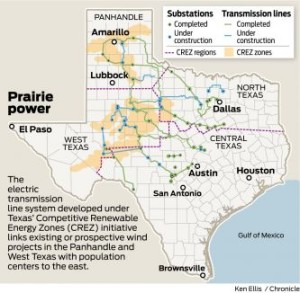Solar Power Coming to Texas in a Big Way, Part Two

Robert Menard,
Certified Purchasing Professional,
Certified Professional Purchasing Consultant, Certified Green Purchasing Professional, Certified Professional Purchasing Manager
Editor’s Note: this is the second of a two part series on the near future of solar generated electricity in Texas, a state famously known for its oil and gas energy. This Part deals with applications while Part One looks at the landscape, quite literally.
The geography problem
With solar generation farms located in western Texas and population centers located in eastern Texas, the obvious problem is how to deliver electricity from origin to consummation points. It happens, rather happily, that the Texas terrain suitable for solar is also suitable for wind generation. In 2013, the Competitive Renewable Energy Zone (CREZ), a legislative creation of the Public Utilities Commission of Texas (PUCT) authorized and funded seven transmission and distribution utilities to build $7 billion worth of high-voltage transmissions lines that will eventually transmit about 18,500 megawatts (enough for 370,000 residences) of wind power from western Texas and the Panhandle to highly populated more eastern and central metropolitan areas of the state.
ERCOT believes that these new transmission lines can handle the upcoming solar load as well because most wind is generated at night and solar is an obvious day time phenomenon. Solar is also far more reliable a renewable source than is wind. See the illustration below which appeared in the Houston Chronicle.
Sunny skies do not extend to the Texas residential sector
Geographic distances and associated losses in voltage drop and waste heat do not apply to residential solar power where panels are mounted directly on home rooftops so energy loss in transmission is nil. Yet, the residential market remains clouded.
 Electric retailers in Texas like TXU and Reliant are aggressively marketing their leased roof top panels to residential customers. The cash outlay of customers is much less than an outright purchase but the return is proportionally reduced. Other companies try to sell them by offering much higher returns and sales of excess electricity back to the grid. According to Reliant president Elizabeth Killinger, “It’s not my expectation that half of Texas customers will go solar overnight. We think this is the beginning.” Let’s hope she is right.
Electric retailers in Texas like TXU and Reliant are aggressively marketing their leased roof top panels to residential customers. The cash outlay of customers is much less than an outright purchase but the return is proportionally reduced. Other companies try to sell them by offering much higher returns and sales of excess electricity back to the grid. According to Reliant president Elizabeth Killinger, “It’s not my expectation that half of Texas customers will go solar overnight. We think this is the beginning.” Let’s hope she is right.
Meanwhile, back east in New Jersey…
An embarrassing attempt to place a solar farm on the site of an abandoned landfill has proven to be disastrous. ENR reported in its 30 June 2014 edition that an unreleased and delayed New Jersey Dept. of Environmental Protection (NJDEP) report may show that landfill materials have contaminated water in local streams. NJDEP states that the report, when released, will not show any significant and/or lasting damage to the watershed from the landfill. HUH?
The NJDEP press director did admit that the effort to put a solar farm on the landfill had gone horribly wrong. Nevertheless, most similar projects in NJ to put solar farms on brownfield sites have been successful, according to ENR.
So what went wrong?
Accusations are being tossed around. The contractor on the failed Fenimore landfill in Roxbury, NJ project has been removed by NJDEP. Litigation has predictably followed. One principal of the contractor has previous convictions for bribery of a public official.
God bless Texas.